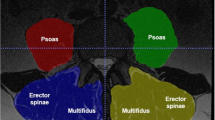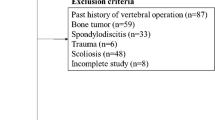Abstract
Objective
To investigate the relationship between paraspinal and psoas muscle volumes and acute osteoporotic or low-bone-mass compression fractures of the lumbar spine in postmenopausal women.
Methods
Patient data were retrieved retrospectively for postmenopausal women with L-spine magnetic resonance imaging (MRI) and dual-energy X-ray absorptiometry showing osteoporosis/low bone mass. Group 1 comprised eight women aged 60–80 years with MRI showing a single acute compression fracture. The age-matched group 2a (N = 12) and younger group 2b (N = 12) comprised of women whose MRIs showed no fractures. Cross-sectional MRIs of the paraspinal and psoas muscles and intramuscular fat volume for each muscle group were measured. Operator repeatability and reproducibility were obtained.
Results
Group 1 showed significantly smaller lean muscle volume for all muscle groups at L5/S1. Intramuscular fat volume was also smaller in most muscle groups in group 1, though only reaching statistical significance at variable muscle groups and levels. Measurements show both good intrarater repeatability and interrater reproducibility of lean muscle volume estimations (intraclass correlation coefficient (ICC), 0.999 for rater A and 0.997 for rater B; Cronbach’s alpha 0.995) and intramuscular fat volume estimations (ICC, 0.995 for rater A and 0.982 for rater B; Cronbach’s alpha was 0.981).
Conclusions
This study provides the first quantitative evidence that compression fractures in postmenopausal women with underlying osteoporosis/low bone mass are associated with less paraspinal and psoas muscle volumes. Further longitudinal studies with larger cohorts are needed to verify this relationship.
Key Points
• The risk of osteoporotic compression fractures is higher in older women with smaller paraspinal muscle volume.
• Older women show smaller paraspinal muscle volume and more intramuscular fat compared to younger controls.

Similar content being viewed by others
Abbreviations
- BMD:
-
Bone mineral density
- BMI:
-
Body mass index
- CSA:
-
Cross-sectional area
- DXA:
-
Dual-energy X-ray absorptiometry
- ES:
-
Erector spinae
- ICC:
-
Intraclass correlation coefficient
- IVD:
-
Intervertebral disc
- L-spine:
-
Lumbar spine
- MF:
-
Multifidus
- MRI:
-
Magnetic resonance imaging
- ROI:
-
Region of interest
References
(2000) Osteoporosis prevention, diagnosis, and therapy. NIH Consens Statement 17:1–45
Pfeifer M, Sinaki M, Geusens P, Boonen S, Preisinger E, Minne HW (2004) Musculoskeletal rehabilitation in osteoporosis: a review. J Bone Miner Res 19:1208–1214
Marshall D, Johnell O, Wedel H (1996) Meta-analysis of how well measures of bone mineral density predict occurrence of osteoporotic fractures. BMJ 312:1254–1259
Cruz-Jentoft AJ, Baeyens JP, Bauer JM et al (2010) Sarcopenia: European consensus on definition and diagnosis: report of the European Working Group on Sarcopenia in Older People. Age Ageing 39:412–423
Delmonico MJ, Harris TB, Lee JS et al (2007) Alternative definitions of sarcopenia, lower extremity performance, and functional impairment with aging in older men and women. J Am Geriatr Soc 55:769–774
Rosenberg IH (1997) Sarcopenia: origins and clinical relevance. J Nutr 127:990s–991s
Bauer JM, Sieber CC (2008) Sarcopenia and frailty: a clinician’s controversial point of view. Exp Gerontol 43:674–678
Szulc P, Beck TJ, Marchand F, Delmas PD (2005) Low skeletal muscle mass is associated with poor structural parameters of bone and impaired balance in elderly men—the MINOS study. J Bone Miner Res 20:721–729
Jun HS, Kim JH, Ahn JH et al (2016) The effect of lumbar spinal muscle on spinal sagittal alignment: evaluating muscle quantity and quality. Neurosurgery 79:847–855
Hsu WL, Chen CY, Tsauo JY, Yang RS (2014) Balance control in elderly people with osteoporosis. J Formos Med Assoc 113:334–339
Curtis E, Litwic A, Cooper C, Dennison E (2015) Determinants of muscle and bone aging. J Cell Physiol 230:2618–2625
Pereira FB, Leite AF, de Paula AP (2015) Relationship between pre-sarcopenia, sarcopenia and bone mineral density in elderly men. Arch Endocrinol Metab 59:59–65
Genaro PS, Pereira GA, Pinheiro MM, Szejnfeld VL, Martini LA (2010) Influence of body composition on bone mass in postmenopausal osteoporotic women. Arch Gerontol Geriatr 51:295–298
Rochefort GY, Pallu S, Benhamou CL (2010) Osteocyte: the unrecognized side of bone tissue. Osteoporos Int 21:1457–1469
Di Monaco M, Vallero F, Di Monaco R, Tappero R (2011) Prevalence of sarcopenia and its association with osteoporosis in 313 older women following a hip fracture. Arch Gerontol Geriatr 52:71–74
Kim JY, Chae SU, Kim GD, Cha MS (2013) Changes of paraspinal muscles in postmenopausal osteoporotic spinal compression fractures: magnetic resonance imaging study. J Bone Metab 20:75–81
Danneels LA, Vanderstraeten GG, Cambier DC, Witvrouw EE, De Cuyper HJ (2000) CT imaging of trunk muscles in chronic low back pain patients and healthy control subjects. Eur Spine J 9:266–272
Takayama K, Kita T, Nakamura H et al (2016) New predictive index for lumbar paraspinal muscle degeneration associated with aging. Spine (Phila Pa 1976) 41:E84–E90
Keller A, Gunderson R, Reikerås O, Brox JI (2003) Reliability of computed tomography measurements of paraspinal muscle cross-sectional area and density in patients with chronic low back pain. Spine (Phila Pa 1976) 28:1455–1460
Stokes M, Rankin G, Newham DJ (2005) Ultrasound imaging of lumbar multifidus muscle: normal reference ranges for measurements and practical guidance on the technique. Man Ther 10:116–126
Kamaz M, Kireşi D, Oğuz H, Emlik D, Levendoğlu F (2007) CT measurement of trunk muscle areas in patients with chronic low back pain. Diagn Interv Radiol 13:144–148
Lee JC, Cha JG, Kim Y, Kim YI, Shin BJ (2008) Quantitative analysis of back muscle degeneration in the patients with the degenerative lumbar flat back using a digital image analysis: comparison with the normal controls. Spine (Phila Pa 1976) 33:318–325
Cheung KM, Karppinen J, Chan D et al (2009) Prevalence and pattern of lumbar magnetic resonance imaging changes in a population study of one thousand forty-three individuals. Spine (Phila Pa 1976) 34:934–940
Hebert JJ, Koppenhaver SL, Parent EC, Fritz JM (2009) A systematic review of the reliability of rehabilitative ultrasound imaging for the quantitative assessment of the abdominal and lumbar trunk muscles. Spine (Phila Pa 1976) 34:E848–E856
Kalichman L, Hodges P, Li L, Guermazi A, Hunter DJ (2010) Changes in paraspinal muscles and their association with low back pain and spinal degeneration: CT study. Eur Spine J 19:1136–1144
Zhi-Jun H, Wen-Bin X, Shuai C et al (2014) Accuracy of magnetic resonance imaging signal intensity ratio measurements in the evaluation of multifidus muscle injury and atrophy relative to that of histological examinations. Spine (Phila Pa 1976) 39:E623–E629
Hu ZJ, He J, Zhao FD, Fang XQ, Zhou LN, Fan SW (2011) An assessment of the intra- and inter-reliability of the lumbar paraspinal muscle parameters using CT scan and magnetic resonance imaging. Spine (Phila Pa 1976) 36:E868–E874
Ropponen A, Videman T, Battié MC (2008) The reliability of paraspinal muscles composition measurements using routine spine MRI and their association with back function. Man Ther 13:349–356
Holm L, Olesen JL, Matsumoto K et al (2008) Protein-containing nutrient supplementation following strength training enhances the effect on muscle mass, strength, and bone formation in postmenopausal women. J Appl Physiol (1985) 105:274–281
Kader DF, Wardlaw D, Smith FW (2000) Correlation between the MRI changes in the lumbar multifidus muscles and leg pain. Clin Radiol 55:145–149
Berry DB, Padwal J, Johnson S, Parra CL, Ward SR, Shahidi B (2018) Methodological considerations in region of interest definitions for paraspinal muscles in axial MRIs of the lumbar spine. BMC Musculoskelet Disord 19:135
Mengiardi B, Schmid MR, Boos N et al (2006) Fat content of lumbar paraspinal muscles in patients with chronic low back pain and in asymptomatic volunteers: quantification with MR spectroscopy. Radiology 240:786–792
Heymsfield SB, Adamek M, Gonzalez MC, Jia G, Thomas DM (2014) Assessing skeletal muscle mass: historical overview and state of the art. J Cachexia Sarcopenia Muscle 5:9–18
Paalanne N, Niinimäki J, Karppinen J et al (2011) Assessment of association between low back pain and paraspinal muscle atrophy using opposed-phase magnetic resonance imaging: a population-based study among young adults. Spine (Phila Pa 1976) 36:1961–1968
Mannil M, Burgstaller JM, Held U, Farshad M, Guggenberger R (2018) Correlation of texture analysis of paraspinal musculature on MRI with different clinical endpoints: lumbar stenosis outcome study (LSOS). Eur Radiol. https://doi.org/10.1007/s00330-018-5552-6
Buckinx F, Landi F, Cesari M et al (2018) Pitfalls in the measurement of muscle mass: a need for a reference standard. J Cachexia Sarcopenia Muscle. https://doi.org/10.1002/jcsm.12268
LeBlanc A, Lin C, Shackelford L et al (2000) Muscle volume, MRI relaxation times (T2), and body composition after spaceflight. J Appl Physiol (1985) 89:2158–2164
Lee YH, Hsiao HF, Yang HT, Huang SY, Chan WP (2017) Reproducibility and repeatability of computer tomography-based measurement of abdominal subcutaneous and visceral adipose tissues. Sci Rep 7:40389
Kim BJ, Ahn SH, Kim HM, Lee SH, Koh JM (2015) Low skeletal muscle mass associates with low femoral neck strength, especially in older Korean women: the fourth Korea National Health and Nutrition Examination Survey (KNHANES IV). Osteoporos Int 26:737–747
Addison O, Marcus RL, Lastayo PC, Ryan AS (2014) Intermuscular fat: a review of the consequences and causes. Int J Endocrinol 2014:309570
Hides JA, Richardson CA, Jull GA (1996) Multifidus muscle recovery is not automatic after resolution of acute, first-episode low back pain. Spine (Phila Pa 1976) 21:2763–2769
Hodges P, Holm AK, Hansson T, Holm S (2006) Rapid atrophy of the lumbar multifidus follows experimental disc or nerve root injury. Spine (Phila Pa 1976) 31:2926–2933
Dahlqvist JR, Vissing CR, Hedermann G, Thomsen C, Vissing J (2017) Fat replacement of paraspinal muscles with aging in healthy adults. Med Sci Sports Exerc 49:595–601
Crawford RJ, Filli L, Elliott JM et al (2016) Age- and level-dependence of fatty infiltration in lumbar paravertebral muscles of healthy volunteers. AJNR Am J Neuroradiol 37:742–748
Fortin M, Videman T, Gibbons LE, Battié MC (2014) Paraspinal muscle morphology and composition: a 15-yr longitudinal magnetic resonance imaging study. Med Sci Sports Exerc 46:893–901
Ikezoe T, Mori N, Nakamura M, Ichihashi N (2011) Age-related muscle atrophy in the lower extremities and daily physical activity in elderly women. Arch Gerontol Geriatr 53:e153–e157
Takahashi K, Takahashi HE, Nakadaira H, Yamamoto M (2006) Different changes of quantity due to aging in the psoas major and quadriceps femoris muscles in women. J Musculoskelet Neuronal Interact 6:201–205
Akalan NE, Kuchimov S, Apti A, Temelli Y, Nene A (2016) Weakening iliopsoas muscle in healthy adults may induce stiff knee pattern. Acta Orthop Traumatol Turc 50:642–648
Crawford RJ, Cornwall J, Abbott R, Elliott JM (2017) Manually defining regions of interest when quantifying paravertebral muscles fatty infiltration from axial magnetic resonance imaging: a proposed method for the lumbar spine with anatomical cross-reference. BMC Musculoskelet Disord 18:25
Funding
This work was supported in part by a grant from the Ministry of Science and Technology, Taiwan (MOST 106-2314-B-038-035).
Author information
Authors and Affiliations
Corresponding author
Ethics declarations
Guarantor
The scientific guarantor of this publication is Professor Wing P. Chan.
Conflict of interest
The authors of this manuscript declare no relationships with any companies whose products or services may be related to the subject matter of the article.
Statistics and biometry
One of the authors in the manuscript, Yen-Kuang Lin, PhD, is a statistician.
Informed consent
Written informed consent was waived by the Institutional Review Board.
Ethical approval
Institutional Review Board approval was obtained.
Methodology
• Retrospective
• Observational
• Performed at one institution
Additional information
Publisher’s note
Springer Nature remains neutral with regard to jurisdictional claims in published maps and institutional affiliations.
Rights and permissions
About this article
Cite this article
Huang, C.W.C., Tseng, IJ., Yang, SW. et al. Lumbar muscle volume in postmenopausal women with osteoporotic compression fractures: quantitative measurement using MRI. Eur Radiol 29, 4999–5006 (2019). https://doi.org/10.1007/s00330-019-06034-w
Received:
Revised:
Accepted:
Published:
Issue Date:
DOI: https://doi.org/10.1007/s00330-019-06034-w




